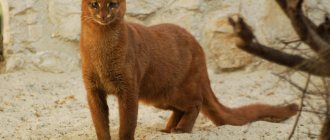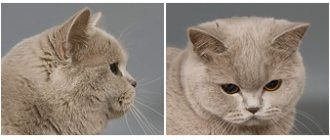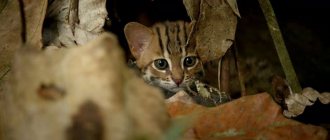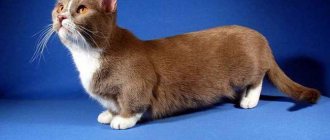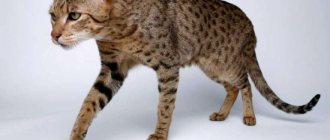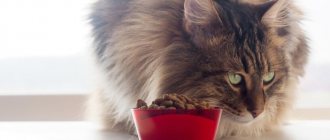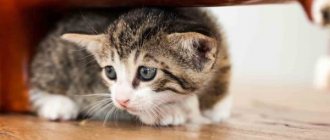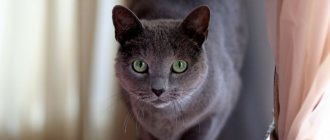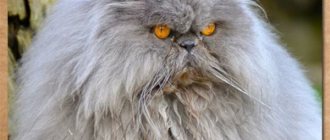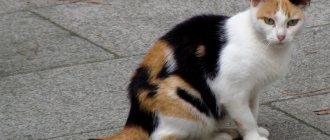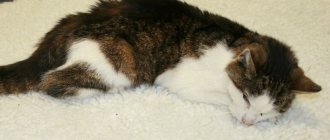The Singapura cat or Singapura is an unusual breed of cat of natural oriental origin. However, it was formed thanks to the efforts of American breeders. The distinctive features of Singaporeans are their extraordinary appearance and amazing character. This breed is one of the smallest cat breeds: the weight of an adult cat reaches 3 kg, and that of a female cat – 2 kg, and is listed in the Guinness Book of Records. Cats of this breed are very elegant and playful.
Singapura cats can only come in one color - sepia agouti, which is a creamy golden shade with brown ticking on the back, tail and head.
The delightful big eyes of Singapura cats definitely attract the attention of everyone who has seen this breed of cat. These cats are very pleasant to stroke, as the coat is silky, short in length and without undercoat.
Singapura cat photo
Singapore cat: history of the breed
It was believed that Singapore cats were ordinary street animals, huddled in city sewers, basements and simply ran around the streets of Southeast Asia. The local population got used to them and did not admire the beauty of these animals, until at the end of the 20th century, an American, amazed by their appearance and miniature size, took several individuals to his homeland, where he suggested to his friend, who was already breeding cats, to pay attention to these cute creatures. They decided to name the animals Singaporean in honor of their homeland. The first who started breeding these cats were the Meadow spouses from the USA.
But difficulties arose with the registration of the breed by felinological organizations. Not wanting to recognize Singaporean beauties, they argued that this animal is not found in Singapore at all (many went there specifically to bring aboriginal animals, but did not find them), but is the result of crossing Abyssinian and Siamese cats. A distinctive feature of the Singaporeans - their miniature size - is just the result of interbreeding, which is absolutely unacceptable. The situation was complicated by the fact that the first cats were exported without the appropriate documents, so the breeders could not confirm their origin.
After much debate, in 1981, the breed was finally recognized, and standards were later developed. It was from this time that Singapore cats became official participants in exhibitions and shows. Feline nurseries not only in the USA, but also in many European countries began to engage in breeding. There are such organizations in Russia; they appeared only in 1995. The Singapore cat breed has transformed from inhabitants of city sewers into one of the most beloved and revered.
Interesting! Before its popularity in Europe and the USA, almost no attention was paid to this cat in Singapore. Now in her homeland she has become a symbol of the country. The Singapore cat, whose photo adorns many souvenirs, is a kind of sign of the state.
Interesting fact about the breed
The breed standards are very strict, especially when it comes to coat color. To be a true Singaporean cat, the pet must have a so-called sable white-gray coat. If you look closely at a Singapura, you will notice that its coat has two different colors. This type of coat is not very common in the “cat world”, which makes Singaporeans stand out from the general “crowd”.
But these cats have a recessive gene that makes breeders worry about each new litter. If it is present, it is possible to give birth to a kitten of only one color. It will still be amazing, but it may not win awards at shows. However, this definitely won’t stop you from loving your owners!
Breed standards for Singaporean cats
The Singaporean cat is easy to recognize. Its bright appearance and miniature size significantly distinguish it from representatives of other breeds. Clear standards have been developed:
- small size (males - 2.5 - maximum 3 kg; females 2 kg);
- rounded head;
- the muzzle is oval, the whisker pads are distinct, the chin is full, the jaws are wide and short;
- the eyes are almond-shaped, large (relative to the size of the muzzle), set slightly obliquely, slightly protruding; color – green, yellow, walnut.
Attention! Impurities in eye color are considered breed defects; they must be exclusively monochromatic.
- the mouth, eyes, antennae points, and nose are edged in dark brown;
- the ears are set straight, open at the base, wide, the shell is deep;
- the body is strong, muscular, small, less often medium-sized, slightly squat;
- the paws are strong, muscular, average length, ending in a small elegant pad, oval in shape;
- the tail is of medium length relative to the body, slightly thicker at the base, ends with a rounded tip, without a tassel;
- the coat is short, shiny, close-lying, the undercoat is insignificant;
Attention! Singaporean cats practically do not shed, so they are suitable as pets for those who are allergic to cat fur.
- sepia-agouti color;
- The color of each hair is light at the base, dark at the end, there are at least two dark zones that alternate with light ones.
Attention! Breed standards clearly distribute dark and light zones on the body of a Singapura cat: the end of the tail is always dark; a dark stripe running from the tail along the back; breast, inner part of legs, muzzle, belly light (delicate cream) color; between the toes the fur is dark brown; dark lines on the forehead; the fur on the cheekbones is slightly darker than the color of the muzzle.
Small Singaporean kittens may have less pronounced colors typical of the breed. The animal acquires its true colors by the age of sexual maturity, approximately one year.
Catering
A good metabolism does not allow lazy Singapura cats to gain weight even with a large meal. But don’t try to feed your pet until he’s a volleyball: it won’t do him any good. The serving size depends on the age, well-being and lifestyle of the animal, but the average for a female is 50-60 kcal, for a male - 60-70 kcal (per 1 kg of weight - 40-60 grams of food).
If a Singapura cat constantly begs for food, this does not mean that it is malnourished. The cause may be a disease of the digestive system, parasites, or a sharp increase in blood sugar. Show the animal to the veterinarian and do not refuse tests.
There should be 2 feedings: morning and evening. After each meal, bowls should be washed to prevent food from turning sour. The water is also changed 2 times a day. You cannot drink tap water - only settled or purified water using a filter.
Twice feeding applies to adult cats older than one year. From 9 months to a year they eat 3 times, from six months to 9 - 4-5 times, up to six months - 5-6 times.
Natural products
It is prohibited to give:
- roast,
- salty,
- fatty,
- smoked,
- pickled,
- sweet,
- many vegetables and fruits (eggplant, avocado, citrus fruits, grapes, tomatoes, white cabbage),
- chicken protein,
- products with artificial colors, flavor enhancers, pieces of fruit, GMOs.
Allowed:
- lean meat (beef, rabbit, veal, turkey, chicken),
- fish (flounder, hake, trout, salmon, halibut),
- dairy products (yogurt, sour cream, cottage cheese, cream, fermented baked milk, hard cheese),
- porridge (rice, buckwheat, millet, oatmeal),
- boiled chicken yolk,
- vegetables (zucchini, carrots, pumpkin, broccoli, asparagus, greens),
- vegetable oils (olive, sunflower, flaxseed).
Recommended food
Among ready-made foods, breeders recommend exclusively holistic foods such as Acana, Farmina N&D, Wildcat and super-premium Natyka, Superpet.
Below are the recommended holistic class foods. Links with the names of the food are clickable, on them you can, within our website, read the descriptions of the food and read reviews from owners of Singapore breed cats.
| Holistic | Holistic | Super premium |
| AATU | Riverwood | Summit |
Singapura cat: character, habits
Singaporean cats, despite their “street” origin, get along well in apartments and houses and become good companions for their owners.
Many breeders note the animal's playfulness. The cat is always happy if people pay attention to her and offer some entertainment. She especially loves to frolic with children and other pets, and her games are very delicate: she will never show aggression or use her claws. But it’s worth removing all breakable and breakable things from tables and shelves - cats really like to climb somewhere.
Pets become attached to people, get bored, are happy when people pay attention to them, and are caressed. These miniature creatures are happy to demonstrate their love and devotion. But don’t think that Singaporeans will bother you with loud meows and calls to play. These cats have an unusually quiet voice and it does not sound often. They probably understand that their expressive eyes will tell the owner more than their sharp cries. And the pets are not wrong about this.
Despite their love for their household and kind attitude towards people, Singaporean cats will not always go into the arms of a stranger. At first they will look at it from the side, sniff it, and only then will they approach it. They behave the same way when they get to a new home. Don’t be alarmed if the animal spends a long time exploring the space and studying you “from afar.” When she realizes that she is in good hands, she will definitely please you with her love and attention.
Singapore cats are very good parents. Their kittens are born very small, much smaller than those of many breeds, because the cat itself is miniature. They protect their kittens, rush to them at the slightest sound, and try not to leave for a minute. And when the kids grow up and begin to walk on their own, they carefully watch to make sure the little ones don’t go too far or fall. Kittens can only be given away when they are 4 months old; that is when they eat on their own and do without the help of their parents.
Attention! The parental instincts of Singapura cats sometimes lead them to take care of the young of other pets, as well as keep an eye on small children. Don't be alarmed if your cat sits near your child's crib - she won't hurt him.
Cats of this breed are also caring towards other family members. The Singapura cat will always notice that you are in a bad mood, will try to calm you down if you accept his attention, or will delicately step aside when you are not in the mood for him, and will patiently wait for your favor. Many breeders claim that Singaporeans are sensitive to human diseases and try to treat them with quiet purring.
General health problems
Every cat owner should keep a close eye on common health problems that occur in any breed, including obesity and ear infections. However, Singapuras also have several health problems that are common to the breed.
Diseases such as:
- Pyruvate kinase deficiency
- Inertia of the uterus (for pregnant women)
Maintenance and care
Singapore cats do not require special care and their maintenance does not burden breeders.
To make your pet comfortable in your home, buy him a vertical house with several shelves and a scratching post, a separate bowl for food and water, and his own tray. Animals are quite smart. If you immediately explain the rules to them, they will not dirty the apartment or steal from other pets’ bowls.
Buy or make toys for your pet, and he will be happy to amuse himself and you with fun activities.
By nature, animals are very neat and spend a lot of time on their own appearance. Their fur does not require additional care; it is enough to brush the cat once a week with a special glove to remove excess hair, especially during the molting period. It is not necessary to bathe Singaporeans.
You should wipe your ears several times a month. To do this, take a cotton swab slightly moistened with water or herbal decoctions and gently rub it along the inside of the ear.
Attention! If you are wiping your pet's ears, make sure that no water drips from the cotton pad. Getting moisture into the ear is highly undesirable!
Origin story
Singapura cats became known to the world quite by accident, and that was thanks to a person completely far from the world of mustaches and tails. Until the mid-20th century, miniature animals survived on their own on the streets without attracting much attention.
But one day everything changed. A certain geophysicist from the United States of America went on a business trip to Singapore and, amazed by the unprecedented beauty, took several individuals to his wife, a cat lover, and a friend who was already breeding at a professional level. It was these four who became the founders of the Singaporean cat breed.
In 1976, Singapore cats were first shown at an exhibition in the USA, and in 1987 - in Belgium. For several years, new blood was poured into the breed, bringing together Singaporean cats with Abyssinian, Burmese, Siamese and cats of other breeds. In the 90s, such mixing was banned.
The first organization to recognize the breed was the TICA federation (in 1979). In 1982, the CFA included the breed in its lists, and a little later - the World Cat Organization. But FiFa still remains unbending.
By 1991, the Singaporean authorities realized that the popularity of their cats was only to their advantage, and publicly declared them a national treasure of the state, erected a monument and imposed strict restrictions on export from the territory of the state.
The Singaporean breed is rare, and finding the animal is not so easy. There are few nurseries in Russia (in Moscow); they are mainly concentrated in the USA. A baby for home care and with some defects in appearance (i.e. without documents and not for breeding) can be bought for 20,000-30,000 rubles. A show class kitten costs more than 100 thousand rubles.
Feeding Singapura cats
Cats of this breed are not picky about food: they can eat both ready-made dry and wet food and natural food. They rarely experience digestive disorders, but it is still recommended to adhere to the following rules:
- include in the diet lean meat of animals or poultry (preferably frozen), fermented milk products, non-red boiled vegetables;
- Pork and any fatty meat, river fish (especially raw), and sausages are strictly prohibited; Milk is poorly digested in adult cats;
- do not feed the animal food from your table, it is harmful to their stomach;
- if you give dry food, be sure to place a bowl of boiled or distilled water.
Despite the fact that Singaporeans are rarely obese, you should not overfeed them. Break your meals into morning and evening meals.
Character and behavior
Singapura cats are peaceful and calm creatures. You can, without fear, have them in families with very young children: they treat children very carefully, not allowing themselves to show aggression towards them. They will be happy to play with the crumbs, but if the child indulges too much, they will quietly sneak away and hide.
However, kittens and teenagers can boast of playfulness, while adults prefer a quieter pastime: lying on the windowsill and looking at pigeons on the balcony, or watching you knead dough. They are curious, but in moderation: they will not jump after a bird from the balcony, just as they will not stick their nose into a boiling pan. They have a well-developed sense of danger, so Singapura cats will even prefer to play it safe.
They are afraid of strangers and prefer to get to know them from a distance: sitting on a closet or under the sofa. Getting used to a new place takes a long time and is difficult. They cannot stand loneliness and may even get sick from boredom.
Clean and tidy. The filling is not thrown out of the tray, food is not pulled out of the bowl. Not vindictive, but touchy. If you crush your tail, you will have to apologize for a long time and atone for your guilt with goodies and strokes.
They are thermophilic, so they will strive to crawl under the owner’s blanket. If you are against this, buy your pet a bed in the shape of a house, place it closer to the radiator and lay a warm blanket inside.
They make very caring and attentive parents, and they calmly raise not only their own, but also other people’s kittens.
Obedient and learn quickly. They can easily be taught to use the toilet, open door handles and even flush water.
Health of Singapura cats
Singapura cats are generally quite healthy and genetic diseases are extremely rare, but there are problems that should be looked out for.
- pets of this breed are prone to catching colds, so you should not leave the animal near the switched on split system or take it for a walk in cold weather; if your cat sneezes often, there is discharge from the eyes and nose, and is lethargic, it is better to contact a veterinarian who will recommend treatment;
Attention! Even a common cold in a cat needs to be treated. An advanced disease can lead to serious consequences!
- Some cats have a difficult birth, so you should not breed the animal before a year and a half, and at the time the kittens appear, it is better to invite a veterinarian; it is possible that the mother cat will have to undergo a caesarean section under general anesthesia;
- Don’t forget to get preventive vaccinations and give vitamins, this will help your pet resist infections and strengthen the immune system.
Health, vaccinations and nutrition
Singapuras are cats in the selection of which people have interfered slightly. They are bred and genetically determined by natural conditions. Therefore, their health is relatively strong and stable. When keeping a cat, you should carefully monitor the condition of the nose, ears, teeth, and pay attention to the mood and appetite.
Cats of this breed are very thermophilic, they cannot stand cold and drafts, so in countries such as Russia and Ukraine it is quite problematic to keep Singaporeans. The tendency to colds is due to the fact that the cat is genetically accustomed to a warm, humid climate; its coat is not designed for frost and cold, so heat transfer increases in cool weather, and the cat begins to freeze.
However, Singapura cats are prone to certain diseases. Some of them are due to the fact that cats gain excess weight after sterilization or with little activity. In this case, they are at risk of diabetes and obesity of internal organs. There are pathologies of the urinary tract and cardiovascular system, and sometimes problems arise in the musculoskeletal system.
The fact that Singapura cats are relatively few in number suggests that they are, one way or another, related to each other. This contributes to the development of infertility, internal pathologies of the reproductive system and related diseases.
If unhealthy symptoms appear (discharge from the ears, nose, eyes, lethargy), you should contact a veterinarian.
Feeding a Singapura cat should be organized correctly, and the diet should consist of balanced food with sufficient amounts of proteins, fats and carbohydrates. It is recommended to use ready-made food, luxury and premium canned food.
If you decide to feed your cat regular foods, exclude fatty meat and poultry (lamb, pork, duck), river fish and any food from the owners’ table from its diet. By giving your cat the “wrong” food, you expose it to disease and shorten its lifespan.
The vaccinations that Singaporeans require are standard. At 12 weeks you should get an anti-infectious vaccination and repeat it a month later. A rabies vaccination is also required.
See also: Russian Blue: a cat in a plush coat with emerald eyes
Singapore cat: photo and price
Despite the fact that the Singaporean cat is very popular, there are not many nurseries in Russia where you can purchase kittens of this breed. Usually on the websites of clubs involved in breeding animals, cats of the Singapore breed are presented, photos of producers, information about breeders, contacts.
By purchasing an animal in nurseries, you receive not only the desired kitten, but also all the documents: a veterinary passport, information about its “relatives” for several generations. This makes it possible in the future to competently engage in mating and participate in exhibitions and shows, where the Singaporean cat has recently been highly valued. The price in rubles or other currencies is not always indicated on the websites, so you need to personally contact the breeders (addresses and telephone numbers must be provided on the pages of the nurseries).
Despite its popularity, the Singapura cat, photos of which demonstrate its unique beauty and grace, still remains rare, and its price is quite high.
Learning ability
When it comes to learning ability, Singaporeans are up to the challenge! Since they love being around their favorite people, are attentive and focused, training with them is a pleasure.
When it comes to workout needs, these babies can fool you. Singapuras are little fluffy balls of energy and it is important for them to get enough play, jumping and prancing every day to stay healthy. If the family is large, it is advisable that everyone takes part in this. This will provide many of the short, intense play “sessions” that cats need. And this will give everyone the opportunity to spend quality time with their pet.
General information
The Singapore cat, or Singapura, is a rare, unique and very unusual breed. Due to its small size (an adult animal looks like a 5-month-old kitten of medium-sized purebred cats), it is listed in the Guinness Book of Records as the world's smallest cat. An adult female weighs on average up to 2 kg, and a male weighs 2.5-3 kg.
Not a single photograph can convey the amazing color, which seems to be illuminated from within. This shade is not found in any other breed. Golden-cream coat with dark brown ticking on the back and head. Add to this huge almond-shaped eyes and large ears.
Despite its size, the Singapura has strong bones; it is a strong and agile animal that easily masters vertical and horizontal surfaces.
Diseases
Like all breeds that were bred by nature itself, Singaporean cats are distinguished by truly indestructible health. If you provide good care and proper nutrition, the most that a Singaporean can catch is a cold. Once ill, the animal becomes lethargic, constantly sneezes, and rubs its muzzle with its paw. The temperature may rise slightly, clear mucous discharge from the nose appears, and the mouth is constantly slightly open. Sometimes the mucous membrane of the eyes becomes inflamed, and the animal seems to cry.
At the first sign of a cold, your cat should be taken to a veterinarian immediately. This disease can be cured fairly quickly, but causes a lot of inconvenience to the cat. Don't forget that your pet can't even blow his nose! It’s hard for him to eat, drink, and breathe.
Singaporeans do not tolerate cold and damp well. Perhaps this is why they have not become widespread in our harsh climate.
Relationships with children and other pets
Singapura cats are absolutely devoid of aggression. A playful and intelligent kitten will become a wonderful companion for your child, provided that you instill in your child a love of animals. Partnerships are the most important thing. Singapura will frolic selflessly, mastering new tricks and techniques. And cats of this breed are very happy when there are other pets in the house: cats, dogs, etc. They get along well with other animals, because they prefer a large company rather than loneliness.
Disqualification
A serious fault is considered to be a gray or cold tone of the coat, a gray undercoat located close to the skin, invisible defects in the tail and a straight profile with various “necklace” shapes.
A Singaporean can be disqualified from an exhibition on the following grounds:
- “necklace” closed around the neck and/or “bracelets” on the paws;
- small eyes and/or ears;
- tail rings;
- noticeable tail defects;
- White spots;
- blue eyes;
- no ticking;
- any color except the true one - sepia agouti.
